.
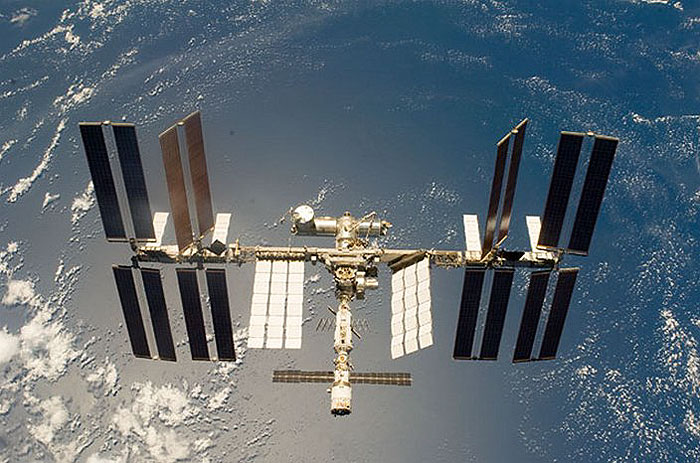
NASA currently is seeking proposals from the U.S. public for exploration technology demonstration and International Space Station National Lab utilization enhancements. (NASA)
-
Space Station NASA Research Announcement Talks Tech
.
Put on your thinking cap! Beginning Nov. 30, NASA wants your ideas on how to use the International Space Station as a technology test bed. NASA's Technology Demonstration and National Lab Offices are asking for proposals on advanced and improved exploration technologies for testing and refinement that take advantage of the unique environment aboard the space station.
The NASA Research Announcement, or NRA, titled "Soliciting Proposals for Exploration Technology Demonstration and National Lab Utilization Enhancements" was issued on Nov. 14. This opportunity to use the orbiting laboratory provides applicants access to the microgravity environment of space, crew support and robotic servicing.
"We are very excited to release this research announcement," said Andrew Clem, an engineer in NASA's Technology Demonstration Office. "We hope that it will provide an opportunity to either demonstrate an important technology necessary for the future of human spaceflight or to develop an upgrade of existing space station capability to improve the quality of research."
This NRA closes Sept. 30, 2013, providing nearly a year to brainstorm and submit proposals. NASA will review white papers and proposals throughout the year as they come in and will cover launch and integration costs for winning proposals. Successful submissions may be eligible for additional funding and should indicate if they require NASA funds.
"The International Space Station is a world-class facility and a critical part of NASA's plan to extend humankind's presence beyond low-Earth orbit," said Clem. "The space station allows for demonstration of critical capabilities for long-duration human spaceflight and generation of interest in science, technology, engineering and mathematics education."
A potential inventor's recipe for success should include a concept to reduce mass, maintenance and power requirements, while also increasing efficiency, reliability and safety. This could be a new technology or an idea to modify and improve on existing space hardware. Proposals also may have the potential to yield benefits for humanity and even stimulate economic growth.
"The International Space Station National Lab represents an opportunity to utilize our unique research capacities to expand the U.S. economy using space-based research, applications and operations," said Clem. "We are excited that this capability is available for non-traditional NASA users."
Technologies should aid in advancing exploration and research capabilities aboard the station. Concepts must fit within existing NASA standards for mass and volume to meet requirements for current launch vehicles, as detailed in the NRA. A sample of suggested areas to get creative juices flowing include, but are not limited to, in-space propulsion; space power and energy storage; components of highly reliable, closed-loop, human health, life support and habitation systems; thermal systems; robotics, telerobotics and autonomous systems; and human exploration destination systems.
From a National Laboratory perspective, concepts also may delve into hardware and analytical upgrades to innovate research capabilities. This could include new uses for existing experiment tools and infrastructure aboard the space station, in addition to potential efficiencies, such as advances to data communications. For instance, the NRA suggests topics in the areas of ground equipment for space studies, on-orbit analytical tools and three dimensional cell and tissue culture hardware, as well as improvements or new uses for existing station research resources.
The analytical and equipment enhancements sought in this announcement will further the efforts made by the Center for the Advancement of Science in Space, or CASIS, to promote research aboard the portion of the station designated a U.S. National Laboratory. CASIS manages the national lab with the goal of supporting and accelerating innovations and new discoveries to benefit humanity here on Earth.
-
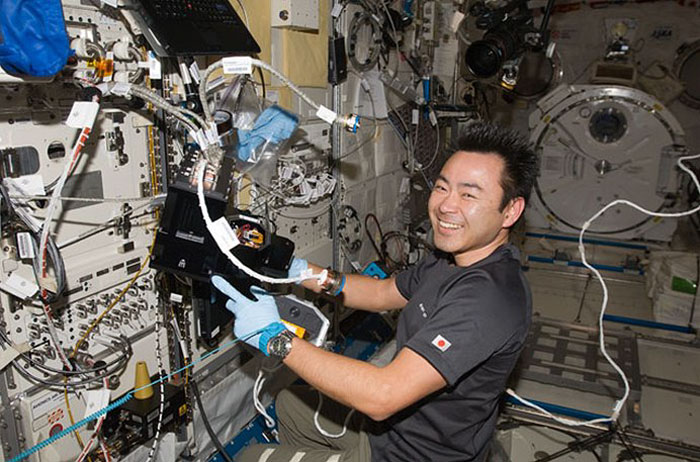
Japan Aerospace Exploration Agency astronaut Aki Hoshide, Expedition 33 flight engineer, services the Nano Step payload in the Japanese Experiment Module. Ideas submitted for the "Soliciting Proposals for Exploration Technology Demonstration and National Lab Utilization Enhancements" may lead to new instruments or improvements on how to use existing hardware aboard the space station. (NASA)
-
Crew Conducts Physics Experiments; Robotic Tests Wrap Up
-
The six Expedition 34 crew members focused on physics experiments and upgrades to their orbital home Friday, wrapping up a busy week of scientific research and robotics aboard the International Space Station.
Following the crew’s daily planning conference with flight control centers around the world, NASA astronaut and Expedition 34 Commander Kevin Ford kicked off another session with the InSPACE-3 experiment, which examines the physical property changes in fluids containing ellipsoid-shaped particles when a magnetic field is applied. These colloidal fluids are classified as smart materials, transitioning to a solid-like state in the presence of a magnetic field, and this technology may lead to the design of bridges and buildings that can better withstand earthquakes.
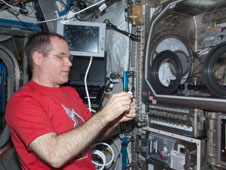
Commander Kevin Ford works with the InSPACE-3 hardware inside the Microgravity Science Glovebox in the Destiny laboratory of the International Space Station. Credit: NASA
-
Ford then replaced a manifold bottle in the Combustion Integrated Rack. This facility, which includes an optics bench, combustion chamber, fuel and oxidizer control, and five different cameras, allows a variety of combustion experiments to be performed safely aboard the station.
After a break for lunch and more work with InSpace-3, Ford joined Flight Engineer Tom Marshburn of NASA for a televised educational event with students gathered at the Putnam Museum of History & Natural Science in Davenport, Iowa. The two astronauts answered questions from the curious students about the work going on aboard the station and the challenges of living in space.
Marshburn also worked with the Japanese Kibo module’s Exposed Facility, often referred to as the station’s “back porch” because it allows astronauts to transfer experiments and hardware to the exterior of the station via an airlock and robotic arm system.
Marshburn spent most of his afternoon working in the U.S. Destiny lab routing High Rate Communications System cable inside module. When fully installed and operational, this system will provide substantially faster uplink and downlink speeds, improved bandwidth, two extra voice communication loops and two additional video downlink channels.
Inside the Quest airlock, Flight Engineer Chris Hadfield of the Canadian Space Agency wrapped up an extensive, multi-day effort to remove and replace the Service and Performance Checkout Unit Heat Exchanger in support of future spacewalks. Hadfield also retrieved some bubble detectors for the RaDI-N experiment, which seeks to characterize the neutron radiation environment of the station.
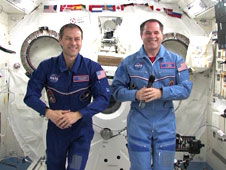
Commander Kevin Ford (right) and Flight Engineer Tom Marshburn greet students at the Putnam Museum in Davenport, Iowa. Credit: NASA TV
-
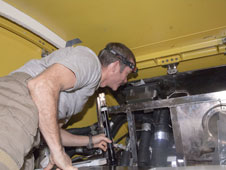
Flight Engineer Chris Hadfield works to remove and replace the Service and Performance Checkout Unit Heat Exchanger inside the Quest airlock. Credit: NASA
-
Space Station to Scan The Globe For Weather Data With ISS-RapidScat
.
Regular measurements of wind speed and direction at the ocean surface alert forecasters to threatening tropical storm conditions, while informing scientists of interactions between the atmosphere and sea currents that influence environmental conditions across the globe.
The observations are most effectively gathered from Earth orbit.
The U.S. lost that capability suddenly in late 2009, when the SeaWinds scatterometer aboard NASA's then 10-year-old QuikScat satellite experienced an age-related antenna failure.
While NASA and the National Oceanic and Atmospheric Administration assess the options for a long term replacement, the Jet Propulsion Laboratory, or JPL, and the International Space Station Program Office at the Johnson Space Center have mobilized to launch a replacement assembled from spare components left over from the development of QuikScat and ADEOS II.
"The ability for NASA to quickly reuse this hardware and launch it to the space station is a great example of a low-cost approach that will have high benefits to science and life here on Earth," said Mike Suffredini, NASA's International Space Station program manager.
ISS-RapidScat will launch to the space station in 2014 aboard a SpaceX Dragon resupply mission. Once unpacked using the station's robot arms, ISS-RapidScat will install on the exterior of the Columbus module.
"ISS-RapidScat represents a low cost approach to acquiring valuable wind vector data for improving global monitoring of hurricanes and other high intensity storms," said Howard Eisen, ISS-RapidScat project manager at JPL. "By leveraging the capabilities of the International Space Station and recycling left over hardware, we will acquire good science data at a fraction of the investment needed to launch a new satellite."
Planning was initiated at JPL by Robert Gaston, the QuikScat operations manager, and Ernesto Rodriguez, the ISS-RapidScat project scientist, to enlist the space station as a platform for a SeaWinds replacement and jelled in March 2012, following a series of science and cost assessments.
Scatterometers function as active, all-weather radar systems. As their high frequency pulses bounce off the ocean surface, the echo returns with wind velocity and directional data. By combining satellite cloud imagery with wind field readings, forecasters can improve their predictions for gale force winds, storm surges and coastal flooding.
"From a forecaster's point of view, any sort of additional information you can get to help with hurricanes will be extremely useful," said Rodriguez.
ISS-RapidScat will play another important role by complementing scatterometers currently flying aboard the polar orbiting European Metop A and B and Indian OceanSat-2 satellites to gather data for climate models. Those models address subtle changes in El Nino, the warm Pacific Ocean equatorial current that influences weather across the U. S. Southwest, and other interactions between the sea and atmosphere that affect the polar ice masses and the world's rain forests.
While not in a polar orbit, the space station's high inclination trajectory will enable ISS-RapidScat to regularly cross the orbit tracks of its three companions and allow the NASA replacement to serve as an important calibration source.
The station's course will also take ISS-RapidScat over the Earth's surface at constantly changing times of day. Ocean winds are greatly influenced by solar radiation, which also varies with the time of day, trends that currently escape the notice of the European and Indian scatterometers that cross the same regions of the Earth at about the same local time each day.
"ISS-RapidScat will be a very useful instrument. By having something that makes all the instruments, which are slightly out of tune with each other, a better complement is extremely useful,” said Rodriguez. "We really require multiple decades of data in order to see some of the uncertainties relative to climate. It's key to have consistently cross calibrated, multi-decadal measurements."
-
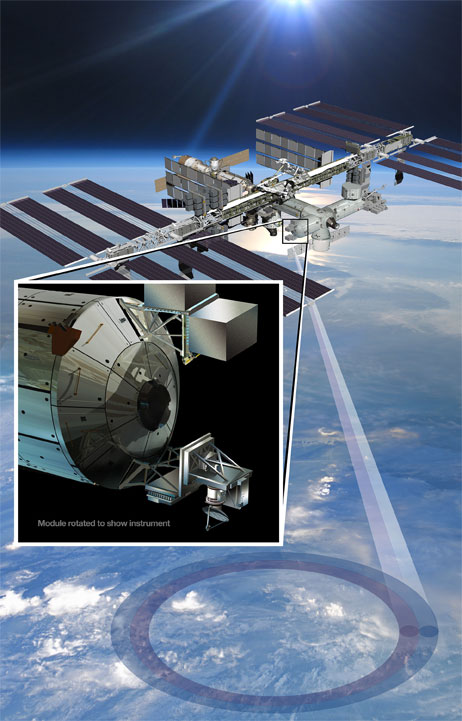
An artist's concept showing the International Space Station-RapidScat instrument against the station. (NASA JPL/Caltech)
-
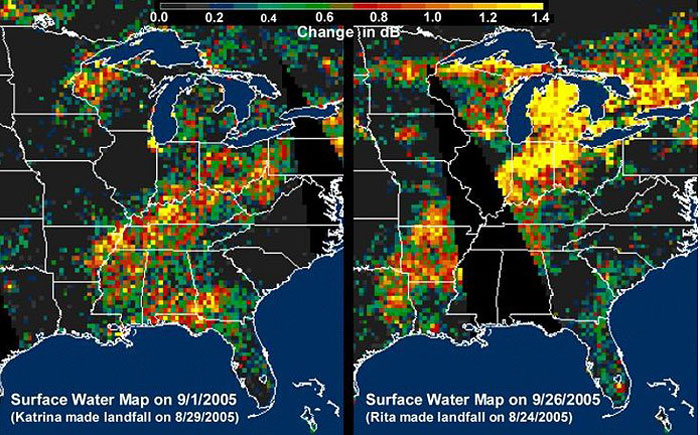
The above images, derived from NASA QuikScat satellite data, show the extensive pattern of rain water deposited by Hurricanes Katrina and Rita on land surfaces over several states in the southern and eastern United States. These results demonstrate the capability of satellite scatterometers to monitor changes in surface water on land. (NASA/JPL/QuikScat Science Team)
View large image
-
Quelle: NASA
6718 Views
